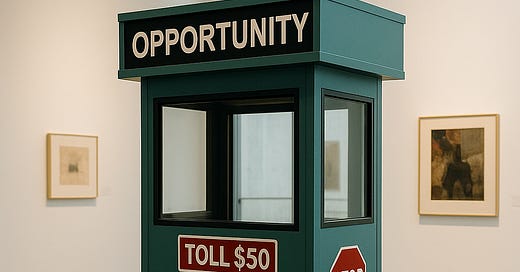Behind every open call, residency, or fellowship application is an invisible toll: time, labor, and emotional bandwidth. But increasingly, there's also a literal one—$25 here, $50 there—the price of being considered. The cost of opportunity has been quietly offloaded onto the applicant, transforming access into a transactional experience. It’s not just about who’s qualified—it’s about who can afford to try. And the irony is hard to ignore: these programs often claim to uplift emerging artists, underrepresented voices, people like me. But if access requires capital, is it really access? In a field that prides itself on equity, charging for the possibility of entry feels less like inclusion and more like monetized hope—a creative economy that profits from our desire to belong.
The Price of Possibility
What does it mean when even possibility has a price tag? For many artists, writers, and cultural workers—especially those from historically excluded backgrounds—the answer is clear: it means fewer chances to be seen, supported, or selected. Every application fee becomes a small tax on ambition, a quiet signal that access is conditional. It’s not just the $35-$95 submission fee. It's the reality that you may need to apply to ten, fifteen, even twenty programs in a year to land one. Suddenly, what’s marketed as “opportunity” starts to look more like a pay-to-play system dressed in the language of merit.
This isn’t about wanting a shortcut or expecting to be handed anything. Most of us understand that the hustle is part of the process. But the monetization of access turns a process of hopeful participation into one of calculated risk. It forces artists to weigh each application not just on alignment or fit, but on cost—financial and emotional. And when access becomes something you buy into, the very notion of equity starts to unravel.
Who Gets to Apply—and Who Gets Left Out
For those of us without trust funds, tenured mentors, or institutional pipelines, fellowships and residencies aren’t just résumé padding—they’re lifelines. They offer time, resources, and legitimacy in a field where all three can feel just out of reach. For artists coming to this work later in life, or through nontraditional paths, these opportunities can be the bridge between the margins and the map. Which makes it all the more infuriating that access to them is gated by fees.
If you’ve worked a full-time job while building your creative practice on nights and weekends, you understand the stakes. You know a residency might offer your first uninterrupted stretch of time to create. That a fellowship could make your work visible—legitimate, even—to an institution, or maybe just to yourself. And yet, the very people who would benefit most from these opportunities are the ones forced to pause and ask: Can I afford to apply?
The result is a quiet sorting system: those who can afford to take a chance, and those who can’t. And when gatekeeping comes disguised as administrative cost, it becomes harder to call out. But the impact is clear—access becomes less about merit, and more about means.
When Aspiration Becomes a Business
This isn’t just about fellowships or residencies. It’s about the creeping logic that everything—every hope, every dream, every chance—is something you should pay for the privilege to pursue. From contests to conferences, grad school applications to portfolio reviews, the creative field has become a marketplace of possibility, where visibility is for sale and access comes with a processing fee.
What’s worse is how normalized it’s become. We’re expected to see these fees as the cost of ambition, to accept that selective access is just part of the “ecosystem.” But when the infrastructure of opportunity is built around monetized hope, what we get isn’t equity—it’s a soft-lit hustle.
And here’s the twist: the people charging these fees aren’t always villains. Some are small, underfunded organizations just trying to keep the lights on. Others are well-meaning collectives operating with reduced budgets in a landscape gutted by arts funding cuts. But even broken systems can reproduce the very inequities they claim to resist. Good intentions don’t cancel out impact. If access comes at a cost, we have to be honest about who’s being left behind—and who’s profiting from the illusion of inclusion.
A Note on Reciprocity
To be fair, I understand the argument: reviewing hundreds of applications takes time, and time is money. But is there truly no room left for generosity? No space for giving back to the communities we claim to serve? If you’ve benefitted from these structures—if a residency or fellowship gave you a shot—shouldn’t there be some part of you that wants to keep the door open for someone else, even if it costs you a little time? Not everything needs to be a transaction. Not every moment of labor needs to be monetized. Sometimes, the most radical thing we can do is simply offer our time—to give, freely, what was once given to us.
Rethinking Access
What would it mean to create systems that don’t just reward those with resources, but actively make space for those without them? To build opportunities around abundance rather than scarcity? Access shouldn’t be a luxury item. Visibility shouldn’t come with a surcharge. And ambition shouldn’t be penalized by cost.
It’s easy to talk about inclusion. It’s harder to embody it—especially when it requires sacrificing a bit of comfort, convenience, or control. But if we really believe in supporting underrepresented artists, in diversifying the field, in democratizing the arts, then we have to confront the uncomfortable truth: charging people to be considered isn’t just unsustainable—it’s unethical.
This isn’t a call to burn it all down. It’s a call to reconsider what we value, and how we show it. A reminder that generosity is a form of resistance. And if equity is the goal, we can’t keep charging people just to be seen.
Because what good is an open door if there’s a fee just to walk through?





